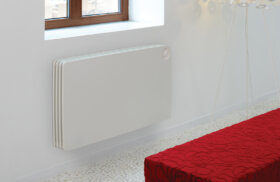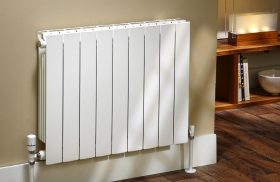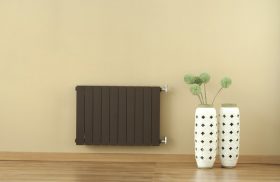If you have noticed that some of your radiators are taking longer to heat up than others, it’s likely that your radiators need balancing. It can be a time-consuming process but it’s highly necessary for efficient and even heat distribution in your home. In the event that your radiators do need balancing, you could hire a plumber to help you. But if you don’t mind rolling up your sleeves, you should be able to do it yourself so your heating system is balanced and ready for winter.
What is radiator balancing?
Radiator balancing is a method of ensuring that hot water reaches all the radiators in your heating system. It involves adjusting your radiator valves to make sure all your radiators heat up at the same speed. Balancing your radiators correctly has a direct effect on how efficiently a condensing boiler operates and plays a key role in maximising heat distribution.
Unbalanced heating systems can lead to some radiators not heating up properly, resulting in parts of your home feeling cooler. When this happens, you might think you need to turn up the thermostat, however, this will cause the other rooms to be too warm and use too much energy. Ultimately, you’ll have an inefficient use of energy and higher heating costs.
Signs of Unbalanced Radiators
There are common signs that you should look out for as these could indicate radiator imbalance.
- Some rooms get hotter than others
- Your rooms take longer to reach the desired temperature
- Differences in room temperatures
- Your thermostat needs to be set much higher or lower to reach a comfortable temperature
- Hissing or gurgling noises
It’s important to take note of the above signs, especially if your rooms are being heated up at different rates. If you notice any of these issues, then it’s a good idea to consider trying to balance your heating system.
Benefits of Radiator Balancing
So why do you need to balance radiators? There are certain benefits that will help you to save energy and money while enjoying a well-heated home.
Improved comfort
When you balance radiators, they will perform much more efficiently so your rooms are heated up properly. There’s nothing worse than leaving your warm bedroom and entering a cold hallway in the winter. With balanced radiators, you will have optimum temperatures and be able to enjoy every room in your home without having to keep fiddling with the thermostat!
Even heat distribution
If your radiators are unbalanced, they will not heat up at the same speed as each other. However, after balancing your radiators, you allow more water to flow to the colder radiators and restrict the flow from the radiators that are too hot. As a result, the radiators heat up at an even rate and all your rooms will be equally warm and comfortable.
Energy efficiency
When you notice one room not heating up as well as another, you might think it’s a problem with the thermostat and end up turning it higher. But this becomes extremely inefficient as the real issue is unbalanced radiators. And once balanced, your heating system will work more optimally and be energy efficient.
Cost savings
Not only does balancing radiators ensure your home is perfectly heated, you can also save on your heating bills. Because you’re giving the correct balance to each radiator, you ensure your boiler doesn’t keep turning on and off, resulting in a nice smooth flow. This means your central heating system is using less energy than it would be if you turned your thermostat up.
Steps to Balancing Radiators
If you find that your radiators aren’t working properly and do in fact need to be balanced, here’s a step-by-step guide on how to go about it.
What you’ll need
- Radiator bleed key
- Lockshield valve or adjustable spanner
- Digital thermometer
Balancing radiators: Step-by-step guide
- Bleeding radiators to remove trapped air: Grab your radiator bleed key and bleed radiators that have cold spots and then ensure they’re heating up all over the surface of the radiator.
- Turn off your central heating: Switch off your heating completely and let all your radiators cool down.
- Open the radiator valves: Open your radiator valves – both the manual valves and Thermostatic Radiator Valves (TRVs) can be opened by hand. The lockshield valves require a lockshield valve adjuster or an adjustable spanner to turn the metal valve.
- Turn the heating back on: Put the heating back on and take note of which order the radiators heat up in as this is the order you’ll be balancing in. Typically, the radiators closer to the boiler will heat up first.
- Turn the heating back off: Wait for the radiators to cool down before starting the balancing process.
- Turn the heating back on again: With your heating back on, and all the radiator valves open, head to the first radiator to balance.
- Turn the lockshield end to balance the radiator: Turn the lockshield valve off using the adjuster or spanner then turn it a quarter or half-turn back. After it heats up again and reaches your desired temperature, you can move onto the next radiator. Note: using the lockshield valve pushes the heat through to the next radiator thereby distributing the flow between the radiator and the next one in line.
- Check the temperature: To ensure that the radiator has been balanced, check the temperature using your thermometer. Take the temperature at the pipework near the lockshield valve, then at the pipework at the other end of the radiator near the Thermostatic Valve. There should be a 12-degree temperature difference between the two sides – if so, then you’re good to go!
- Continue the process on each radiator:Repeat the steps on each radiator until you’re at the end of the line and voila! Your central heating system has now been balanced.
Get expert advice on how to balance radiators
So for optimal heating system performance, make sure that your radiators are balanced and working efficiently. This will not only assist you to keep your home warm in the winter, it’ll also limit your energy usage and heating bills.
In the instance of a complex heating system or if you aren’t comfortable balancing radiators on your own, you will need to call a professional. Chat to us for more expert advice on radiator balancing and we’ll be happy to help.





